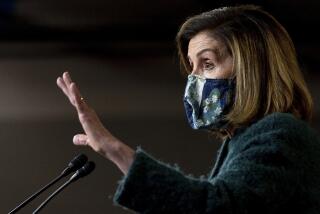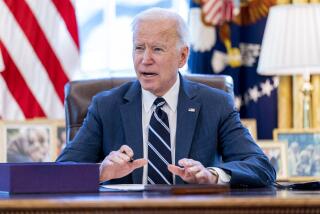Wrestling with scope of aid plans
- Share via
In three news conferences last week, President-elect Barack Obama began to outline an economic stimulus and recovery program involving public works, tax breaks and new federal funding for energy research.
The planned initiatives provided a spark of optimism amid the nation’s worsening financial outlook, but elements crucial for a sustained recovery are yet missing and many important details remain to be filled in, economists say. These include Obama’s approach to mortgage relief and the structure of a bailout of the automobile industry.
Some of the gaps may be deliberate, as insiders debate the size and scope of the package. Liberal economists in particular argue that to be effective, the program will have to be massive.
“The most important elements will be size and duration -- $300 to $500 billion and two years sounds right,” said Jared Bernstein, an economist with the Economic Policy Institute.
Others say that placing a dollar figure on the program now, while the magnitude of the economic slowdown is still unknown, may only hamstring the new administration.
“He’s wise not to put a figure on it yet,” said Robert Kuttner, an informal advisor to Obama’s electoral campaign and founding co-editor of the American Prospect, a journal of liberal commentary. “Six weeks from now it might be a bigger number.”
To be sure, some conservative economists say Obama is planning to do too much, not too little.
“Whatever federal spending is included in the package eventually will have to be paid for by raising taxes, printing money or additional borrowing, all of which drags on the private economy,” William F. Shughart II, a former economist at the Federal Trade Commission and professor of economics at the University of Mississippi, said in an e-mail.
“It would be better to do nothing than to foist more government boondoggles on the backs of America’s taxpayers,” he added.
But mainstream economists tend to argue that battling a major slowdown demands that the government temporarily step in, with deficit spending if necessary, to substitute its own resources for evaporating private investment.
“It should be direct and it should be big,” said Steven Fazzari, an economist at Washington University in St. Louis. “And it should create economic activity.”
Obama has said little about how he intends to address the housing and mortgage crisis -- an indispensable fix for a sustained recovery, economists say.
The crisis confounds fiscal policymakers even as it threatens millions of homeowners with foreclosure, drives home values down sharply and dangerously undermines the balance sheets of banks and other financial institutions across the country.
In an attempt to bring down stubbornly high mortgage rates, the Federal Reserve on Tuesday said it would buy up to $600 billion of debt securities issued by Fannie Mae, Freddie Mac and other government-backed housing finance agencies. The move succeeded, at least in the immediate term, in dropping rates on 30-year fixed mortgages by half a percentage point.
Obama’s campaign platform included proposals to grant a mortgage tax credit to 10 million homeowners who don’t itemize deductions on their tax returns and allow bankruptcy judges to approve principal reductions in residential mortgages.
But thus far he has not responded directly to some of the more aggressive ideas for mortgage relief. These include a proposal endorsed by the National Assn. of Home Builders for the government to subsidize below-market rates of 2.99% for 30-year mortgages attached to homes purchased between now and June 30, and 3.99% for homes purchased from then to the end of 2009.
The group estimates the cost of the measure at more than $140 billion. It argues that the program will drain excess inventory from the housing market, reinvigorating a moribund home construction sector.
Some of Obama’s supporters say that he hasn’t addressed housing in greater detail simply because other fiscal issues demand more urgent attention.
“How much time has he had to focus on the details?” Kuttner said. “When he does, I hope it will become obvious that mortgage relief is important.”
Another issue on which Obama has not taken a detailed stand is the fate of the U.S. automobile industry, which is seeking bridge loans or a bailout to help it survive the sharp drop-off in sales created by the evaporation of credit and the economic slowdown.
The president-elect has backed relief for the Big Three in principle.
“We can’t allow the auto industry to simply vanish,” he said during a news conference Monday after naming Federal Reserve official Timothy F. Geithner as his nominee for Treasury secretary. But he called on the automakers to come up with “a better thought out proposal” to use federal funds when they come before Congress with a new request this month.
Still, Bernstein and other experts argue that, given the potential damage an automaker bankruptcy might inflict on the economy, Obama would be hard-pressed to deny assistance.
“An auto collapse would shift a recession into much higher gear,” Bernstein said. “The economy just can’t take that hit right now.”
One detail of the recovery plan that may not emerge until closer to Inauguration Day is how the money will be disbursed for infrastructure projects. Such undertakings often require long lead times to prepare engineering studies and environmental surveys and address other technical issues, possibly delaying their stimulative effect.
“A project like a subway takes a long time,” said Lawrence E. Harris, a professor of finance at USC’s Marshall School of Business. “But lots of tradesmen who know how to build houses can build community buildings, senior citizen centers and early childhood centers, which don’t take a long time.”
Harris also observed that upgrading the nation’s high-tech infrastructure will pay long-term dividends.
“The air traffic control system could use some new funding,” he said.
--
More to Read
Get the L.A. Times Politics newsletter
Deeply reported insights into legislation, politics and policy from Sacramento, Washington and beyond. In your inbox twice per week.
You may occasionally receive promotional content from the Los Angeles Times.










